The first Woolworths store on this site is referred to in Stanley Holloway’s famous comic monologue and bestseller, Albert and The Lion. Albert was ‘a little lad … swallowed whole’ by the lion in the menagerie at the foot of Blackpool Tower. Albert had prodded the beast with ‘a stick with an ‘orse’s ‘ead ‘andle, the finest that Woolworths could sell’. The original 78rpm monologue recording was sold in Woolworths store in Blackpool in 1923 for sixpence. Holloway later became a character actor and the mainstay of the ‘Ealing’ comedies.
Illustrations, a photograph and text about The Albert and the Lion.
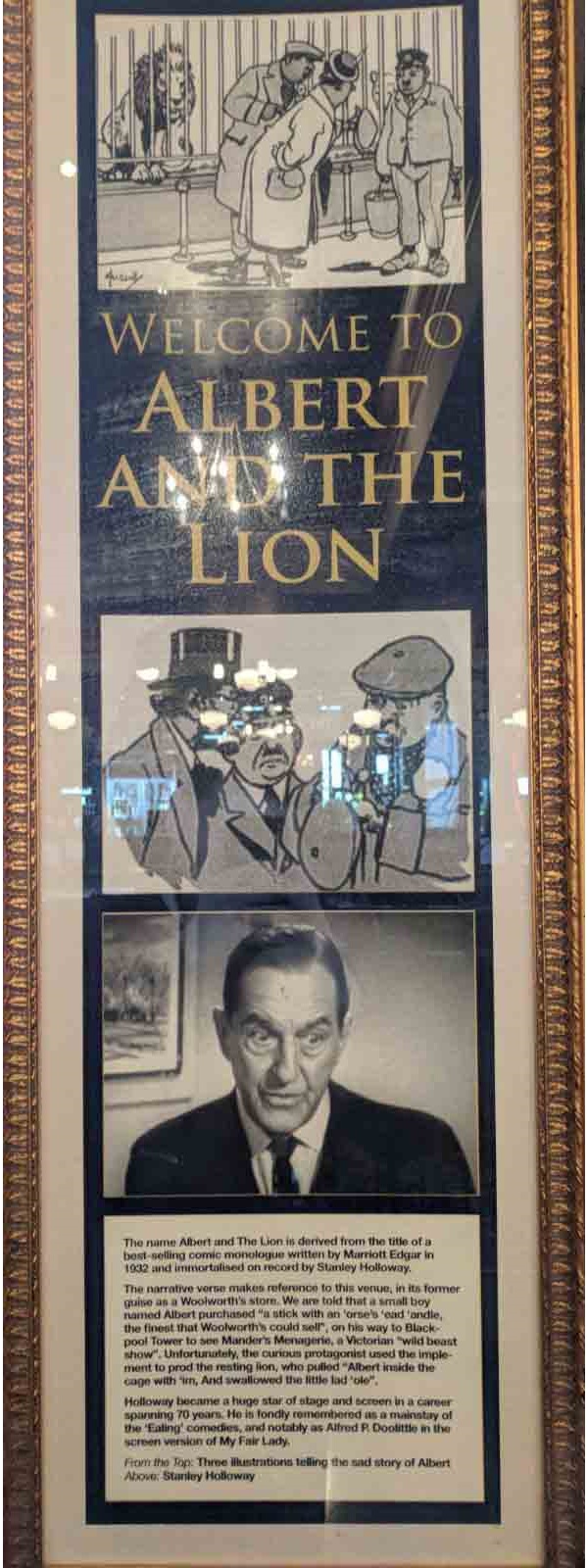
The text reads: The name Albert and The Lion is derived from the title of a best-selling comic monologue written by Marriott Edgar in 1932 and immortalised on record by Stanley Holloway.
The narrative verse makes reference to this venue, in its former guise as a Woolworths store. We are told that a small boy named Albert purchased a “stick with an ‘orse’s ‘ead ‘andle, the finest that Woolworths could sell”, on his way back to Blackpool Tower to see Mander’s Menagerie, a Victorian “wild beast show”. Unfortunately, the curious protagonist used the implement to prod the resting lion, who pulled “Albert inside the cage with ‘im, And swallowed the little lad ‘ole”.
Holloway became a huge star of stage and screen in a career spanning 70 years. He is fondly remembered as a mainstay of the ‘Ealing’ comedies, and notably as Alfred P Doolittle in the screen version of My Fair Lady.
From the top: Three illustrations telling the sad story of Albert
Above: Stanley Holloway.
Prints and text about Blackpool Tower Circus.
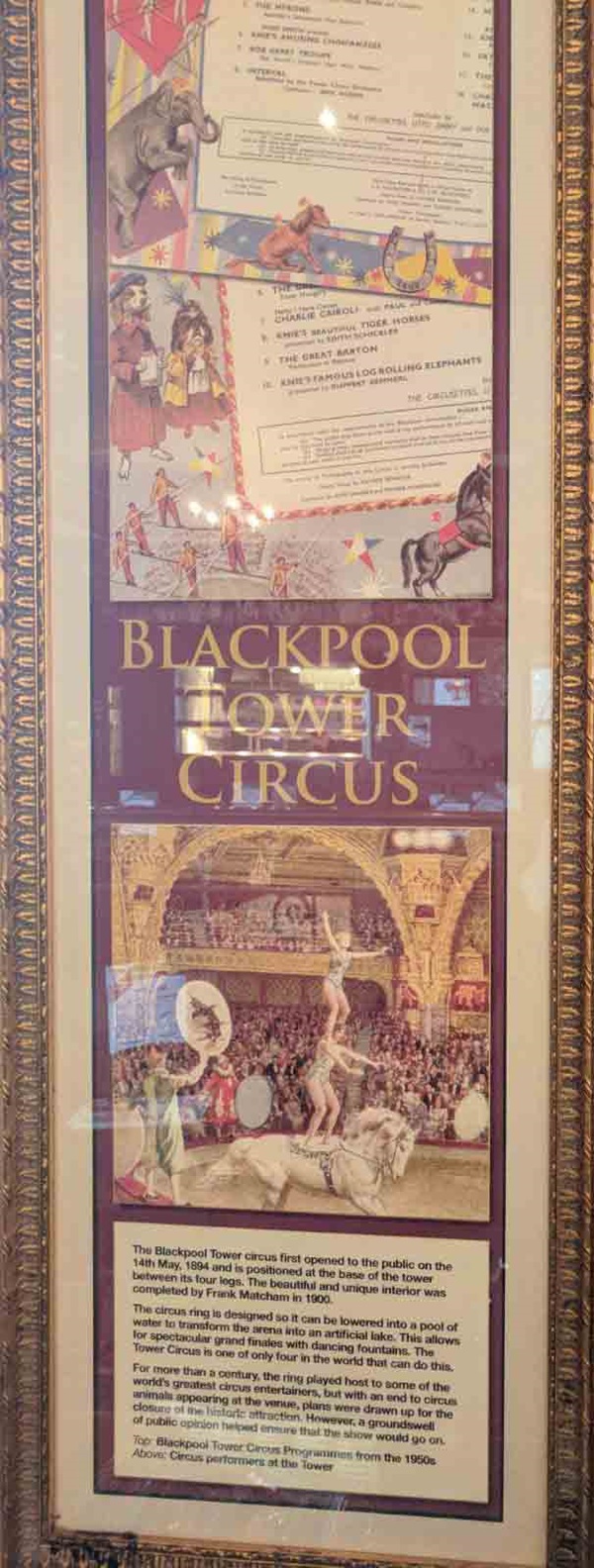
The text reads: The Blackpool Tower Circus first opened to the public on the 14 May, 1894 and is positioned at the base of the tower between its four legs. The beautiful and unique interior was completed by Frank Matcham in 1900.
The circus ring is designed so it can be lowered into a pool of water to transform the arena into an artificial lake. This allows for spectacular and grand finales with dancing fountains. The Tower Circus is one of only four in the world that can do this.
For more than a century, the ring played host to some of the world’s greatest circus entertainers, but with an end to circus animals appearing at the venue, plans were drawn up for the closure of the historic attraction. However, a groundswell of public opinion helped ensure that the show would go on.
Top: Blackpool Tower Circus programmes from the 1950s
Above: Circus performer at the tower.
Photographs and text about Laurel and Hardy.
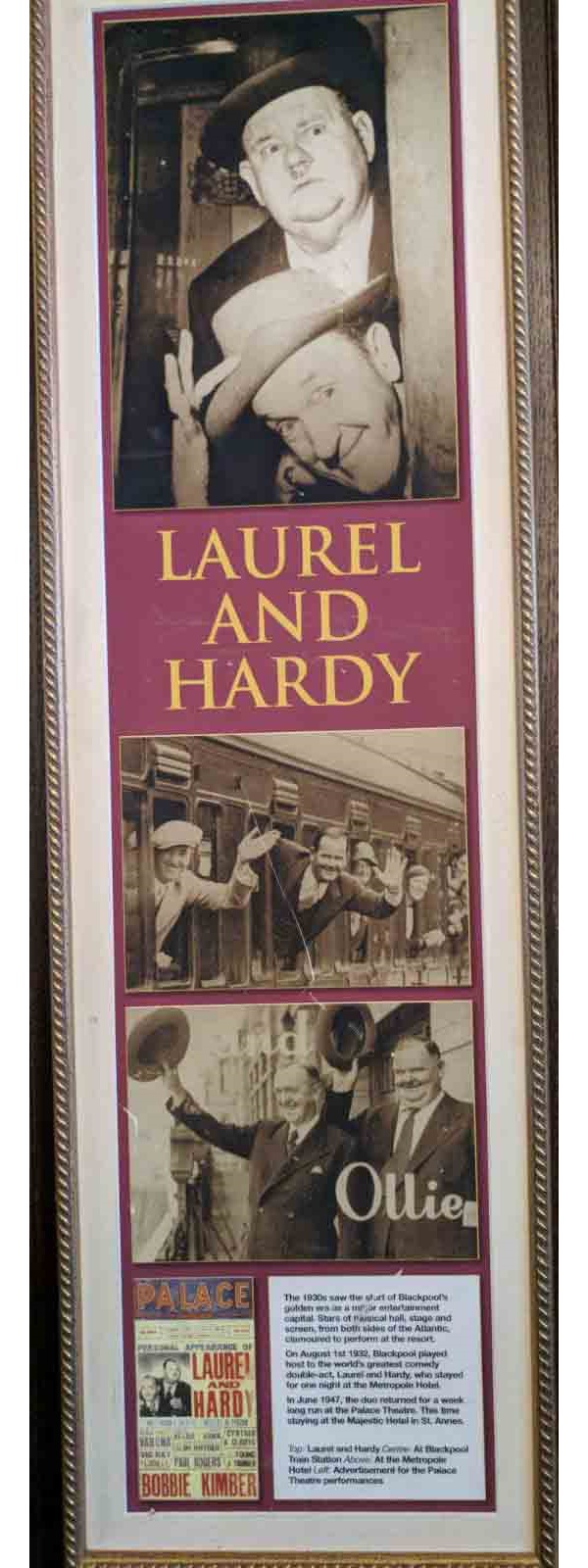
The text reads: The 1930s saw the start of Blackpool’s golden era as a music, or entertainment, capital. Stars of musical hall, stage and screen, from both sides of the Atlantic, clamoured to perform at the resort.
On August 1 1932, Blackpool played host to the world’s greatest comedy double act, Laurel and Hardy, who stayed for one night at the Metropole Hotel.
In June 1947, the duo returned for a week long run at the palace theatre. This time staying at the Majestic Hotel in St Annes.
Top: Laurel and Hardy
Centre: At Blackpool Station
Above: At the Metropole Hotel
Left: Advertisement for the Palace Theatre performances.
A photograph and text about Charlie Cairoli.
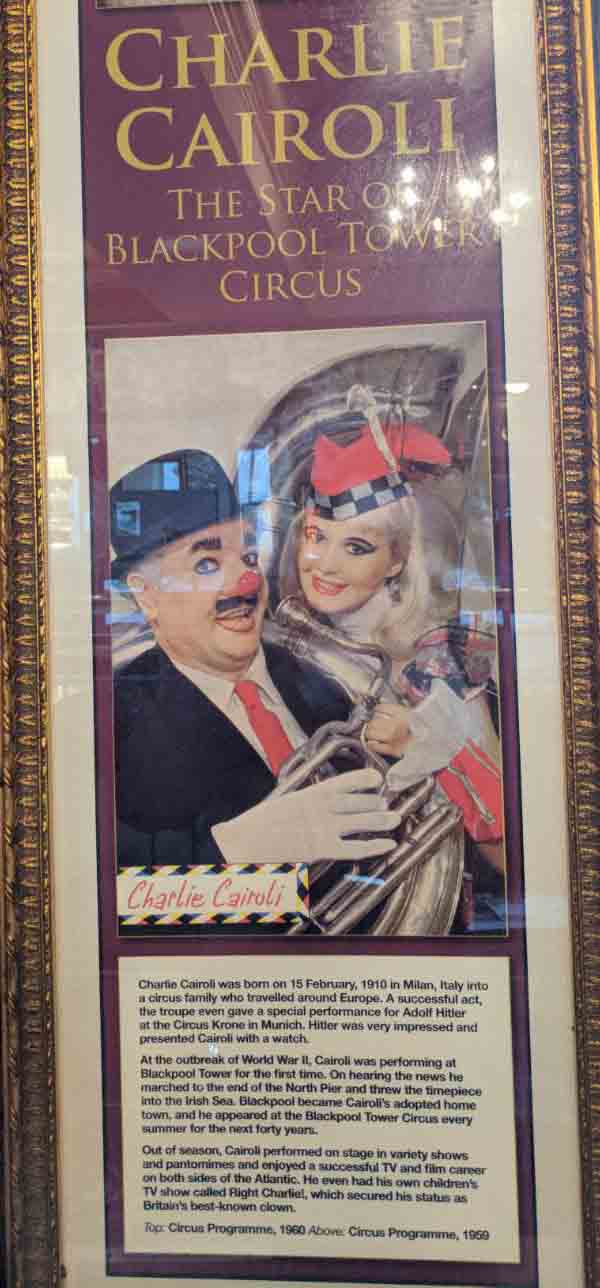
The text reads: Charlie Cairoli was born on 15 February, 1910 in Milan, Italy into a circus family wo travelled around Europe. A successful act, the troupe even gave a special performance for Adolf Hitler at the Circus Krone in Munich. Hitler was very impressed and presented Cairoli with a watch.
At the outbreak of World War II, Cairoli was performing at Blackpool Tower for the first time. On hearing the news, he marched to the end of the North Pier and threw the timepiece into the Irish Sea. Blackpool became Cairoli’s adopted home town, and he appeared at Blackpool Tower Circus every summer for the next forty years.
Out of season, Cairoli performed on stage in variety shows and pantomimes and enjoyed a successful TV and film career on both sides of the Atlantic. He even had his own children’s TV show called Right Charlie!, which secured his status as Britain’s best known clown.
Above: Circus programme, 1959.
Photographs and text about Blackpool Pleasure Beach.
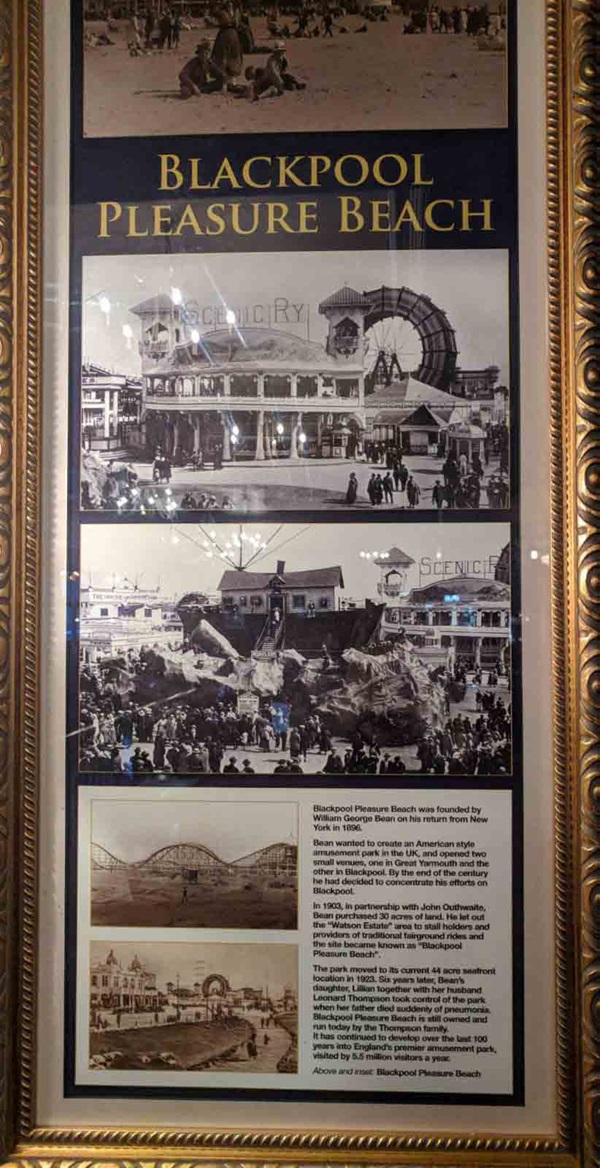
The text reads: Blackpool Pleasure Beach was founded by William George Bean on his return from New York in 1896.
Bean wanted to create an American style amusement park in the UK, and opened two small venues, one in Great Yarmouth and the other in Blackpool. By the end of the century he had decided to concentrate his efforts on Blackpool.
In 1903, in partnership with John Outhwaite, Bean purchased 30 acres of land. He let out the Watson Estate area to stall holders and providers of traditional fairground rides and the site became known as Blackpool Pleasure Beach.
The park moved to its current 44 acre seafront location in 1923. Six years later, Bean’s daughter, Lillian together with her husband Leonard Thompson took control of the park when her father died suddenly of pneumonia. Blackpool Pleasure Beach is still owned and run today by the Thompson family.
It has continued to develop over the last 100 years into England’s premier amusement park, visited by 5.5 million visitors a year.
Above and inset: Blackpool Pleasure Beach.
Photographs and text about the Blackpool Carnival.
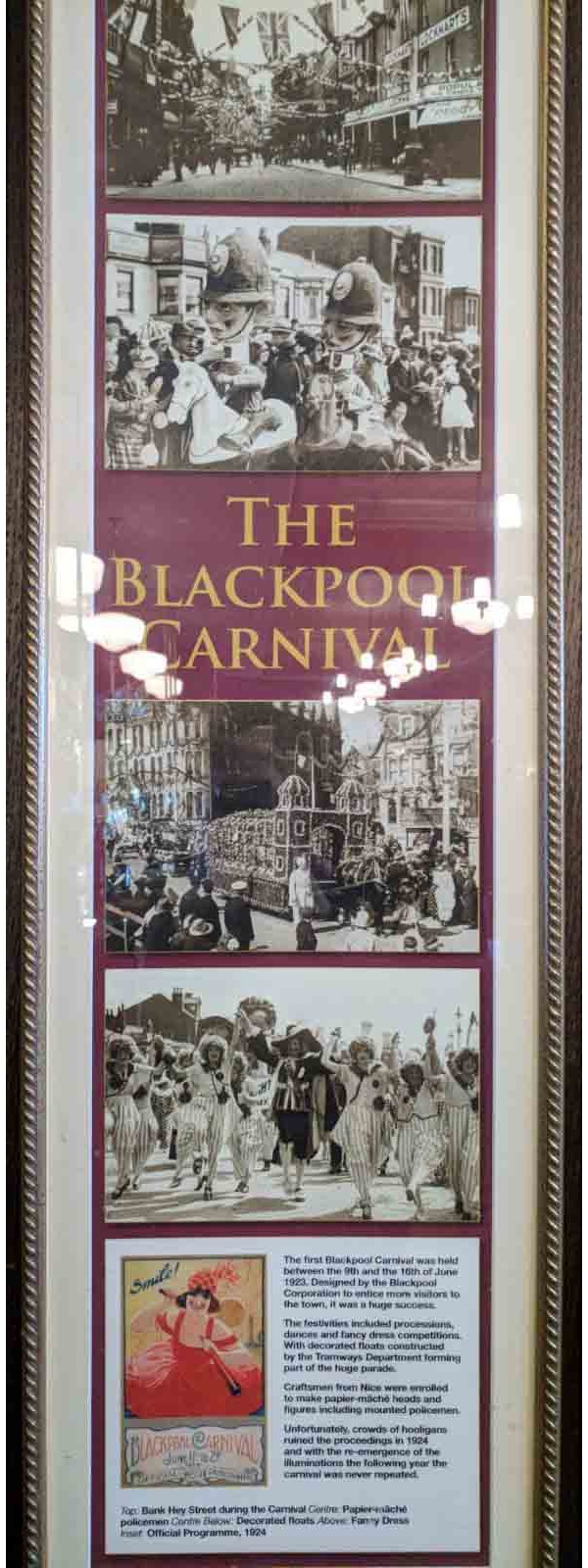
The text reads: The first Blackpool Carnival was held between the 9 and the 16 of June 1923. Designed by the Blackpool Corporation to entice more visitors to the town, it was a huge success.
The festivities included processions, dances and fancy dress competitions. With decorated floats constructed by the Tramways Department forming part of the hue parade.
Craftsmen from Nice were enrolled to make papier-mâché heads and figures including mounted policemen.
Unfortunately, crowds of hooligans ruined the proceedings in 1924 and with the re-emergence of the illuminations the following year the carnival was never repeated.
Top: Bank Hey Street during the carnival. Centre: papier- mâché policemen
Centre, below: Decorated floats
Above: Fancy dress
Inset: Official programme, 1924.
Photographs and text about shipwrecks near Blackpool’s coast.
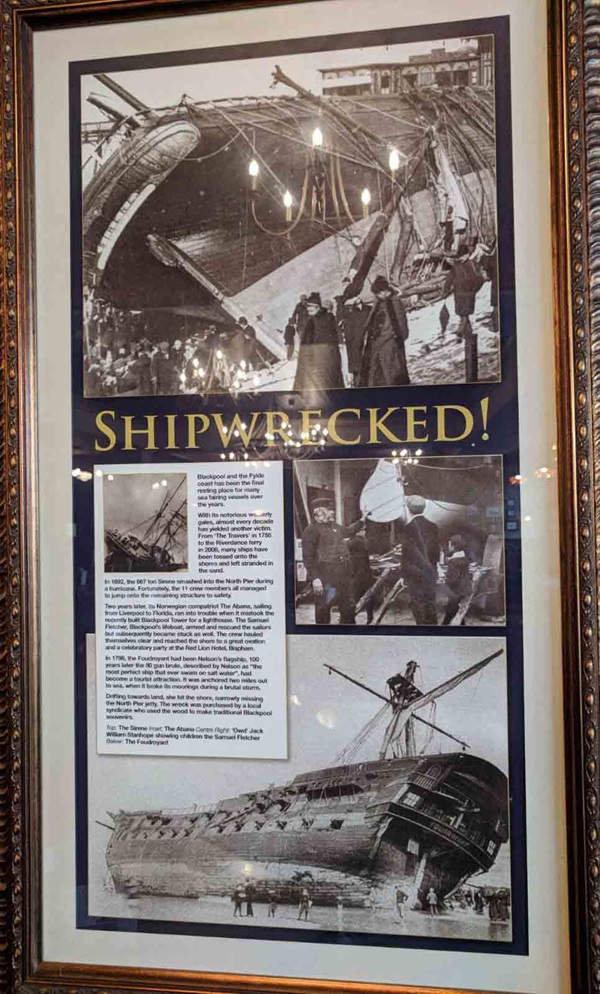
The text reads: Blackpool and the Fylde coast has been the final resting place for many sea fairing vessels over the years.
With its notorious westerly gales, almost every decade has yielded another victim. From The Travers in 1755 to the Riverdance ferry in 2008, many ships have been tossed onto the shores and left stranded in the sand.
In 1892, the 667 ton Sirene smashed into the North Pier during a hurricane. Fortunately the 11 crew members all managed to jump onto the remaining structure safely.
Two years later, its Norwegian compatriot The Abana, sailing from Liverpool to Florida, ran into trouble when it mistook the recently built Blackpool Tower for a lighthouse. The Samuel Fletcher, Blackpool’s lifeboat, arrived and rescued the sailors but subsequently became stuck as well. The crew hauled themselves clear and reached the shore to great ovation and a celebratory party at the Red Lion Hotel, Bispham.
In 1796, The Foudroyant had been Nelson’s flagship, 100 years later the 80 gun brute, described by Nelson as “the most perfect ship that ever swam on salt water”, had become a tourist attraction. It was anchored two miles out to sea, when it broke its moorings during a brutal storm.
Drifting towards land, she hit the shore, narrowly missing the North Pier jetty. The wreck was purchased by a local syndicate who used the wood to make traditional Blackpool souvenirs.
Top: The Sirene
Inset: The Abana
Centre right: ‘Owd’ Jack William Stanhope showing children the Samuel Fletcher
Below: The Foudroyant.
Photographs and text about the North Pier.
The text reads: The North Pier was opened on the 21 May 1863 by Mr F Preston, the chairman of the Pier Company who had commissioned it. As Blackpool’s first pier, the landmark event was attended by some 20, 000 spectators.
It was the second of fourteen piers designed by Eugenius Birch, and is the oldest remaining example of his work. The 500 metre long structure has been continually extended and developed through its lifetime. Theatres, shops and arcades have all been added as well as a landing jetty from which the pleasure steamers, Queen of the Bay and Clifton made excursions to the Lake District, Isle of Man, Llandudno, Southport and Liverpool.
However, the changing face of the North Pier has not always been planned. In 1892 it was struck by the Norwegian ship Sirene, and in 1921 the Indian pavilion, famed for its quality of music, was destroyed in a fire. Its successor met with the same fate in 1938. The current theatre, survived the flames only through the quick reactions of the entertainer Vince Hill, who in 1985, first raised the alarm and then assisted in fighting the blaze.
Grade II listed, Blackpool North Pier today is considered the most traditional of the three Blackpool piers and retains much of its Victorian splendour.
Top: The North Pier Centre: The Sirene
Centre Below: The North Pier
Above: View from the North Pier.
Photographs and text about the Great Wheel.
The text reads: The Great Wheel was erected in 1896 to rival the Blackpool Tower. It was inspired by the ‘Ferris Wheel’ at Earls Court that had been exhibited the previous year. The ride had 30 carriages and was 200 feet in diameter, and weighed in at over 1,000 tons.
However, the wheel failed to enthuse the thrill seekers as it took half an hour to complete one full revolution, as it stopped to load each car. When the Tower Company took over the Winter Gardens in 1928, they dismantled the wheel and replaced it with the Olympia building.
Top, centre and inset: The Great Wheel.
Photographs and text about Blackpool Tower.
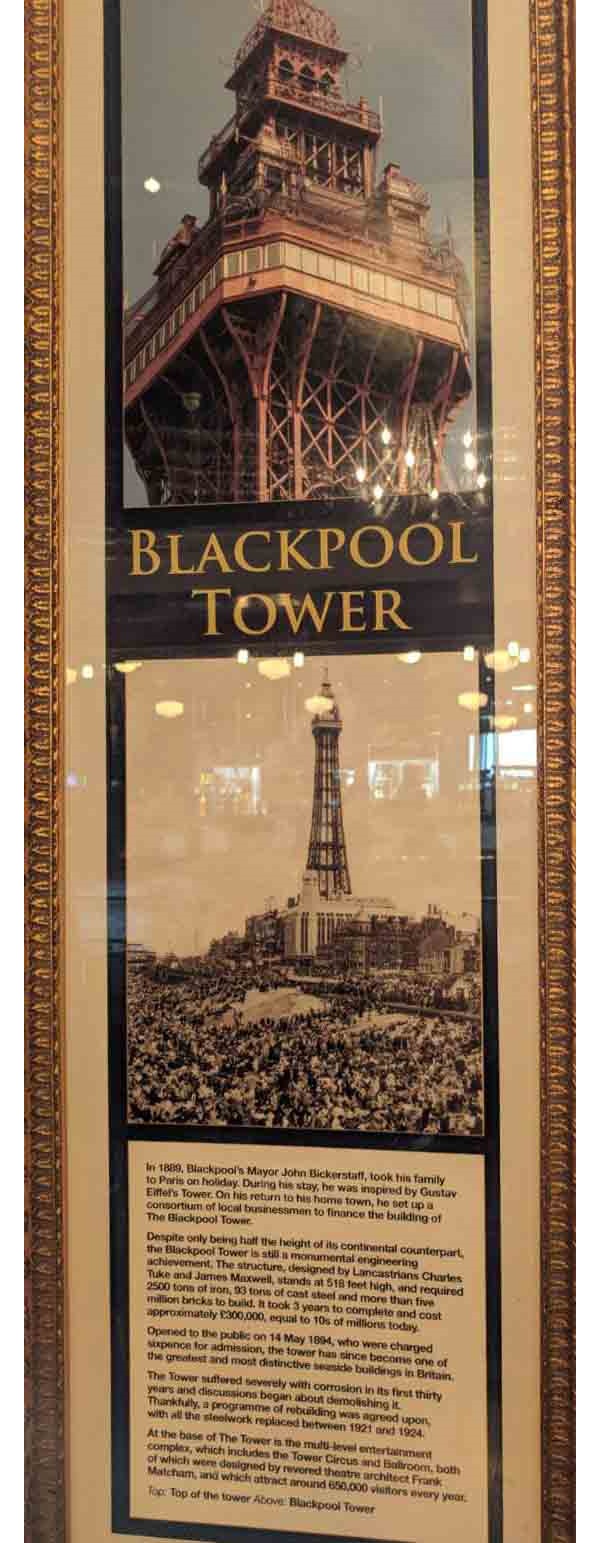
The text reads: In 1889, Blackpool’s mayor John Bickerstaff, took his family to Paris on holiday. During his stay, he was inspired by Gustav Eiffel’s Tower. On his return to his home town, he set up a consortium of local businessmen to finance the building of the Blackpool Tower.
Despite only being half the height of its continental counterpart, the Blackpool Tower is still a monumental engineering achievement. The structure, designed by Lancastrians Charles Tuke and James Maxwell, stands at 518 feet high, and required 2500 tons of iron, 93 tons of cast steel and more than five million bricks to build. It took 3 years to complete and cost approximately £300,000, equal to 10s of millions today.
Opened to the public on 14 May 1894, who were charged sixpence for admission, the tower has since become one of the greatest and most distinctive seaside buildings in Britain.
The tower suffered severely with corrosion in its first thirty years and discussions began about demolishing it. Thankfully, a programme of rebuilding was agreed upon, with all the steelwork replaced between 1921 and 1924.
At the base of the tower is the multi-level entertainment complex, which includes the Tower Circus and Ballroom, both of which were designed by revered theatre architect Frank Matcham, and which attract around 650,000 visitors every year.
Top: Top of the tower Above: Blackpool Tower.
External photograph of the building – main entrance
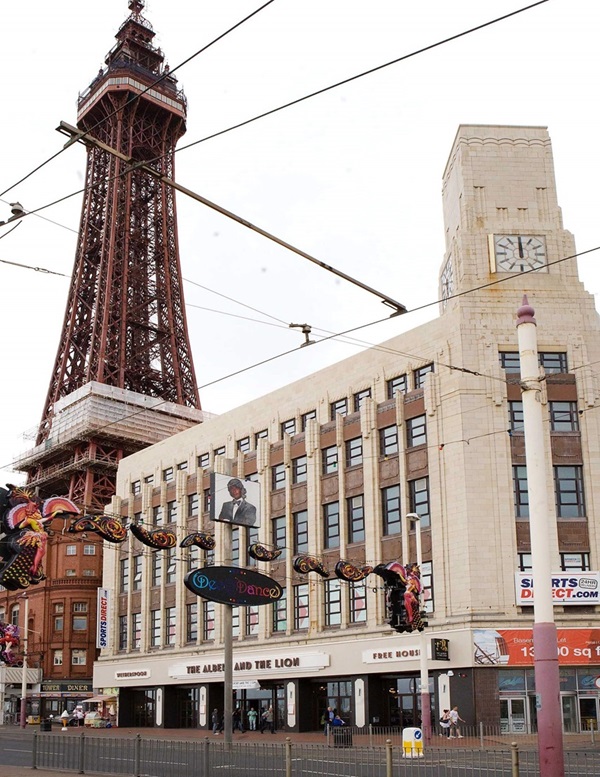
If you have information on the history of this pub, then we’d like you to share it with us. Please e-mail all information to: pubhistories@jdwetherspoon.co.uk